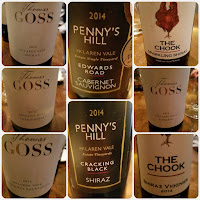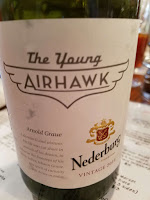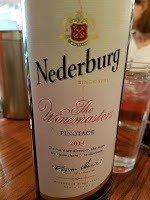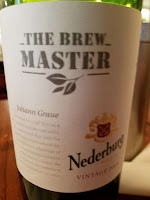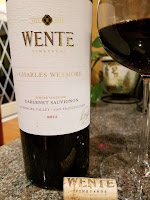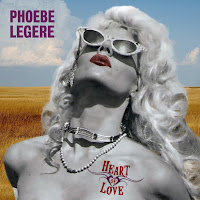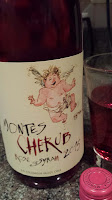During the 2016
Wine Bloggers Conference I participated in the
Livermore Valley Winegrowers Association excursion. This was my first visit to the area but by the end of the trip I had a decent grasp of the major reasons why this is an exciting wine region to visit. In general the Livermore Valley AVA is located less than an hour east of San Francisco and is 25 miles long and 18 miles wide - resembling an oval. Within this area are 4,000 acres of vineyards that contain well draining soils and are blessed with daily maritime breezes that cool the region during the summer. These are interesting factoids but the real reasons to visit the Livermore Valley AVA are listed below.
 Learn About California Wine History
Learn About California Wine History
The Livermore Valley is one of the oldest wine making regions in California. For a quick timeline, in the 1840s Robert Livermore planted the first wine grapes in the valley. Then in 1882 Secretary of the CA Viticultural Commission, Charles Wetmore, established Cresta Blanca Vineyards. In 1883 pioneers
C.H. Wente and James Concannon established
Wente Vineyards Estate Winery and
Concannon.Vineyard respectively. Both are now the oldest continuously-operated, family-owned winery in the country with Wente slightly older. Then, in 1889, the original Judgement of Paris occurred when Wetmore's Livermore Valley Dry White wine won the Grand Prix at the International Paris Exposition. This was the first time an Ameican wine region had won a Gold medal in an international competition, let alone the Gand Prix. California was now on the wine map. And nearly a hundred years later, in 1982, the Livermore AVA was established
Visit the Concannon Cabernet Mother Vine

When James Concannon established his winery he imported vines directly from renowned Château Margaux and Château d’Yquem and became one of the first to produce Bordeaux-style wines in California. In 1960 Jim Concannon, grandson of James, became lead winemaker at Concannon Vineyard. Five years later he collaborated with University of California – Davis in developing three Cabernet Sauvignon clones (7, 8 and 11) from a single vine that James Concannon had earlier imported from Château Margaux. These Concannon Clones have played a major role in California's flourishing Cabernet market where today they account for approximately 80% of California Cabernet Sauvignon. The Mother Vine is located at the beginning of a row near the auxiliary house not far from the tasting room. Make sure you try the
Concannon Vineyard 2013 Mother Vine Cabernet Sauvignon ($36). It is delicious.
Attend the Wente Winemakers Studio
Wente Vineyards is to Chardonnay what Concannon Vineyard is to Cabernet Sauvignon. In 1936 the winery released the first ever varietal-labeled Chardonnay and Wente clones now account for a similar 80% of all California Chardonnay. One source of the Wente clones comes from Charles Wetmore's imported Chardonnay budwood from Meursault in Burgundy. Wetmore had distributed some of this budwood

to the Theodore Gier vineyard in the Livermore Valley. The second major source of the
“Wente clone” occurred in 1912 when Ernest Wente and Leon Bonnet, of UC Davis persuaded C.H. Wente to import Chardonnay cuttings from the vine nursery at the University of Montpellier.
Visitors can learn more about the Wente Chardonnay clones and other wines at the
Wente Winemakers Studio. The program consists of five experiences such as blind tasting, food pairing, aroma training, serving vessels (aka does glass size and share matter), and a blending experience. During our tour we participated in the first four sessions and they were not only enjoyable but also educational. And yes, size does matter. Wente is offering a two for one package through January 2017. Use
VIPVISIT as the promo code. As for the Wente Chardonnays my favorite seemed to oscillate between the fresh and affordable
2015 Morning Fog Chardonnay ($15) and the luscious
2014 Nth Degree Chardonnay (sorry for wine club members only).
Drink From Murrietta's Well

Water that is, not wine. Joaquin Murrieta Carrillo was a famous figure in California lore during the first half of the 1800s, where he was considered a bandit, horse thief, or a Mexican Robin Hood. And either Joaquin or his nephew are considered the basis for Johnston McCulley's Don Diego de la Vega - aka Zorro. Joaquin Murrieta discovered a little used well in the Livermore Valley that he would use to water his horses. In the 1880s Louis Mel purchased the land and planted a vineyard with cuttings from the famed Chateau d’Yquem and Chateau Margaux vineyards. I sense a pattern. He eventually sold the property to his friend Ernest Wente and later Philip Wente and Sergio Traverso revived the winery and opened
Murrieta’s Well. They renovated the original winery and visitors can still see original beams and stones, dragged from the nearby river bed, embedded in the walls. Try the
Murrieta's Well 2015 Small Lot Dry Rosé ($30).
 Taste Petite Sirah
Taste Petite Sirah
In 1964 Jim Concannon released the very first varietal-labeled Petite Sirah from his 1961 vintage which has lead him to be referred to as “The Father of Petite Sirah.” Today the grape is mildly available among Livermore wineries, but the three I sampled were fantastic. As expected, Concannon keeps the tradition alive with a few in their portfolio. I sampled the
Concannon 2010 Reserve Petite Sirah ($40) - a chewy dark fruit wine with a spicy and acidic finish. Beautiful. Next was the
Page Mill Winery 2013 Tazetta Vineyard Petite Sirah ($36) that was similar to the Concannon but more earthy and leathery. Finally popular winemaker Collin Cranor poured us the
Vasco Urbano Wine Company 2013 Heine Petite Sirah ($48) and this may have been my favorite - it's as complex as the others, but oh so smooth.......
Savor White Bordeaux

Although Cabernet Sauvignon hogs the limelight, white Bordeaux wines have been in integral part of the wine history of the Livermore Valley. For it was Sauvignon Blanc and Semillon that comprised Wetmore's Grand Prix winning dry white wine. One current source of Livermore Valley white Bordeaux is the Ghielmetti Estate Vineyard where the
Steven Kent Winery 2015 "Lola" White Wine ($24) and the
3 Steves Winery 2015 Sauvignon Blanc are sourced. The single varietal Sauvignon Blanc was fresh and fruity, yet I yearn for the blends. The "Lola" was just more complex and savory as was the tropical leading
Concannon.Vineyard 2014 Reserve Assemblage Blanc ($24). Concannon also released a dessert white Bordeaux wine in the very rich and tasty
2013 Reserve Late Harvest Semillon-Sauvignon Blanc. Finally, Semillon stood proudly on it's own in the
Cuda Ridge Wines 2015 Mel's Ranch Vineyard Semillon. This creamy tropical wine is a keeper.
 Discover 50 Close Knit Wineries
Discover 50 Close Knit Wineries
There are currently 50 wineries within the Livermore Valley AVA and not only are they close in proximity to each other but there's a shared comradery that was prevalent throughout our tour. One winemaker arrived in a borrowed truck from another winemaker, equipment is passed around as needed, and advice shared readily. In the words of Guy Clark, "That' the kind of stuff I like to be around".
theCompass Winery, Brewery, Distillery Locator Mobile App can help you navigate while driving among the different wineries, but another interesting option is the
Pedego Electric Bikes. Pedal when you want, use the motor on more difficult passages. In any case, I highly recommend a visit to the Livermore Valley AVA. Not only will you sample delicious historic wines, but you will be treated as an honored guest in the tasting room. Cheers.
 On our visit there were five estate wines on the tasting lineup starting with the 2015 Chardonnay ($21). Half the wine undergoes malolatic fermentation and the finished wine is aged eight months in one year old French Oak. The process provides considerable depth and creaminess to this wine without the overbearing buttery-toffee characters. A great value at this price. The 2015 Viognier ($28) is fresh and floral with strong peach flavors. Fermented in steel and aged just four months in neutral oak, this is a refreshing and very acidic wine. The 2015 Rosé ($19) is another fine bargain made from 95% Chambourcin and 5% Cabernet Franc. There's plenty of bright red fruit and acids with the Chambourcin providing a little spicy kick to the finish. The 2014 Gigi Red Blend ($22) is also predominately Chambourcin (25%) with the remaining Cabernet Sauvignon. This is an entry level red, low in tannins, plenty of acids - very smooth on the palate. Perhaps serve a little chilled. But the star of the tasting was undoubtedly the 2014 Cabernet Sauvignon ($32). The wine is aged 18 months in French Oak, which provides a lush, velvety body but doesn't overwhelm the strong dark cherry characters. Even with noticeable tannins, the finish is very smooth and mature.
On our visit there were five estate wines on the tasting lineup starting with the 2015 Chardonnay ($21). Half the wine undergoes malolatic fermentation and the finished wine is aged eight months in one year old French Oak. The process provides considerable depth and creaminess to this wine without the overbearing buttery-toffee characters. A great value at this price. The 2015 Viognier ($28) is fresh and floral with strong peach flavors. Fermented in steel and aged just four months in neutral oak, this is a refreshing and very acidic wine. The 2015 Rosé ($19) is another fine bargain made from 95% Chambourcin and 5% Cabernet Franc. There's plenty of bright red fruit and acids with the Chambourcin providing a little spicy kick to the finish. The 2014 Gigi Red Blend ($22) is also predominately Chambourcin (25%) with the remaining Cabernet Sauvignon. This is an entry level red, low in tannins, plenty of acids - very smooth on the palate. Perhaps serve a little chilled. But the star of the tasting was undoubtedly the 2014 Cabernet Sauvignon ($32). The wine is aged 18 months in French Oak, which provides a lush, velvety body but doesn't overwhelm the strong dark cherry characters. Even with noticeable tannins, the finish is very smooth and mature.








